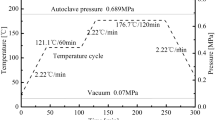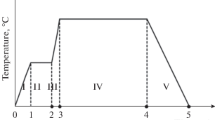Abstract
The uniform curing of a complex-shape composite part can be guaranteed by implementing an optimized thermal cure cycle. An optimal cure cycle reduces the internal stresses generated during composite processing and leads to obtain a high-quality composite part in minimum processing time. In this paper, the optimal design of thermal cure cycle for the production of a complex-shape composite part made from epoxy/glass prepreg is presented. For this purpose, a complete curing optimization algorithm is proposed to minimize the temperature and cure gradients that appear during curing and cooling steps in the different areas of composite part. A complete objective function has been defined based on six sub-objective functions including maximum degree of cure, maximum temperature, cross-over at after gel point (AGP), cure gradients after AGP, temperature gradients and curing time. The variation of density, specific heat capacity and thermal conductivity with degree of cure were taken into account. The optimal thermal cure cycle was automatically designed by linking computer simulation software Abaqus and numerical optimization programs coded in Matlab software. Two different kinetic methods have been considered to determine the kinetic parameters of the curing reaction of the prepreg. The effect of kinetic models on the determination of the optimized cure cycle has been investigated.













Similar content being viewed by others
References
Hayaty M, Beheshty MH, Esfandeh M (2011) Isothermal differential scanning calorimetry study of a glass/epoxy prepreg. Polym Adv Technol 22:1001–1006
Hayaty M, Beheshty MH, Esfandeh M (2011) Cure kinetics of a glass/epoxy prepreg by dynamic differential scanning calorimetry. J Appl Polym Sci 120:62–69
Vafayan M, Beheshty MH, Ghoreishy MHR, Abedini H (2014) The prediction capability of the kinetic models extracted from isothermal data in non-isothermal conditions for an epoxy prepreg. J Compos Mater 48:1039–1048
Dmitriev OS, Kirillov VN, Mischenko SV, Dmitriev SO (2009) Optimization of curing cycles products of the polymer composite materials on base of glutinous prepregs. Polym Sci D 2:223–229
Kennedy GJ, Hansen JS (2010) The hybrid adjoint method: a semi-analytic gradient evaluation technique applied to composite cure cycle optimization. Optim Eng 11:23–43
Milani G, Milani F (2010) Optimal vulcanization of 2D–3D EPM/EPDM thick elements through peroxidic mixtures. J Math Chem 47:229–267
Li M, Zhu Q, Geubelle PH, Tucker CL (2001) Optimal curing for thermoset matrix composites: thermochemical considerations. Polym Compos 22:118–131
Li M, Tucker CL (2002) Optimal curing for thermoset matrix composites: thermochemical and consolidation considerations. Polym Compos 23:739–757
Ruiz E, Trochu F (2005) Comprehensive thermal optimization of liquid composite molding to reduce cycle time and processing stresses. Polym Compos 26:209–230
Ruiz E, Trochu F (2006) Multi-criteria thermal optimization in liquid composite molding to reduce processing stresses and cycle time. Compos A 37:913–924
Pantelelis N (2003) Optimised cure cycles for resin transfer moulding. Compos Sci Techno 63:249–264
Pantelelis N, Vrouvaksi T, Spentzas K (2003) Cure cycle design for composite materials using computer simulation and optimization tool. Forsch Ingenieurwes 67:254–262
Rai N, Pitchumani R (1997) Optimal cure cycles for the fabrication of thermosetting-matrix composites. Polym Compos 18:566–581
Abaqus®/Standard User’s Manual Version 6.10 (2010)
Version 7.5 TheMathWorks Inc. (1984–2007)
Vyazovkin S, Wight CA (1997) Isothermal and non-isothermal reaction kinetics in solids: in search of ways toward consensus. J Phys Chem A 101:8279–8284
Barral L, Cano J, López J, López-Bueno I, Nogueira P, Torres A, Ramírez C, Abad MJ (2000) Cure kinetics of amine-cured diglycidyl ether of bisphenol-A epoxy blended with poly (ether imide). Thermochim Acta 344:127–136
Vyazovkin S, Wight CA (1999) Model-free and model-fitting approaches to kinetic analysis of isothermal and non-isothermal data. Thermochim Acta 340–341:53–68
Vyazovkin S, Sbirrazzuoli N (1999) Kinetic methods to study isothermal and non-isothermal epoxy-anhydride cure. Macromol Chem Phys 200:2294–2303
Sbirrazzuoli N, Mija A, Vincent L, Alzina C (2006) Isoconversional kinetic analysis of stoichiometric and off-stoichiometric epoxy-amine cures. Thermochim Acta 447:167–177
Vyazovkin S (2006) Model-free kinetics: staying free of multiplying entities without necessity. J Therm Anal Calor 83:45–51
Milani G, Milani F (2013) Kinetic FE model to optimize sulphur vulcanization: application to extruded EPDM weather-strips. Polym Eng Sci 53:353–369
Milani G, Milani F (2012) Direct and closed form analytical model for the prediction of reaction kinetic of EPDM accelerated sulphur vulcanization. J Math Chem 50:2577–2605
Wang Q, Storm BK (2003) Characterization of epoxy prepreg SPX 8800 system by isothermal differential scanning calorimetry. Macromol Symposia 193:97–106
Vafayan M, Beheshty MH, Ghoreishy MHR, Abedini H (2013) Advanced integral isoconversional analysis for evaluating and predicting the kinetic parameters of the curing reaction of epoxy prepreg. Thermochim Acta 557:37–43
Vyazovkin S, Dollimore D (1996) Linear and nonlinear procedures in isoconversional computations of the activation energy of nonisothermal reactions in solids. J Chem Inf Comput Sci 36:42–45
Vyazovkin S (1997) Evaluation of activation energy of thermally stimulated solid-state reactions under arbitrary variation of temperature. J Comput Chem 18:393–402
Zou M, Yu B, Zhang D, Ma Y (2003) Study on optimization of transverse thermal conductivities of unidirectional composites. J Heat Transfer 125:980–987
Kalogiannakis G, Hemelrijck DV, Assche GV (2004) Measurements of thermal properties of carbon/epoxy and glass/epoxy using modulated temperature differential scanning calorimetry. J Compos Mater 38:163–175
Scott EP, Beck JV (1992) Estimation of thermal properties in carbon/epoxy composite materials during curing. J Compos Mater 26:20–36
http://www.labeee.ufsc.br/~luis/ga/artigos/Introdu%E7%E3o.pdf
Ghoreishy MHR (2009) Numerical simulation of the curing process of rubber articles. In: Oster WU (ed) Computational materials, Nova Science Publishers, New York, pp 445–78
Miller RA, Kuczmarski MA. NASA/TM-2009-215460
Oh JH, Lee DG (2002) Cure cycle for thick glass/epoxy composite laminates. J Compos Mater 36:19–45
Cecen V, Tavman IH, Kok M, Aydogdu Y (2009) Epoxy- and polyester-based composites reinforced with glass, carbon and aramid fabrics: measurement of heat capacity and thermal conductivity of composites by differential scanning calorimetry. Polym Compos 30:1299–1311
Vafayan M, Abedini H, Ghoreishy MHR, Beheshty MH (2013) Effect of cure kinetic simulation model on optimized thermal cure cycle for thin-sectioned composite parts. Polym Compos 34:1172–1179
Author information
Authors and Affiliations
Corresponding author
Rights and permissions
About this article
Cite this article
Vafayan, M., Ghoreishy, M.H.R., Abedini, H. et al. Development of an optimized thermal cure cycle for a complex-shape composite part using a coupled finite element/genetic algorithm technique. Iran Polym J 24, 459–469 (2015). https://doi.org/10.1007/s13726-015-0337-0
Received:
Accepted:
Published:
Issue Date:
DOI: https://doi.org/10.1007/s13726-015-0337-0




